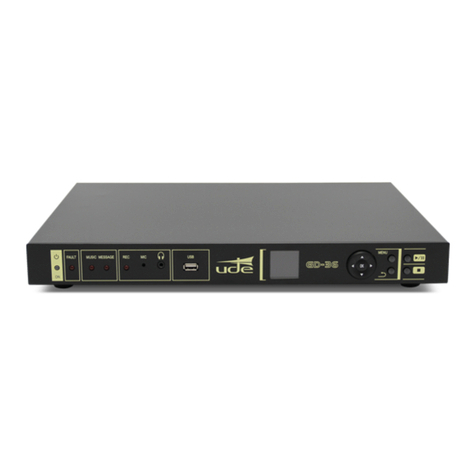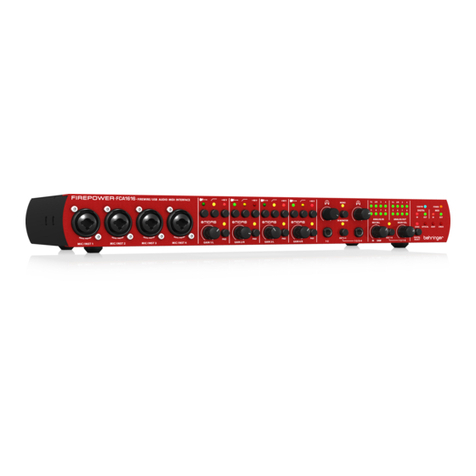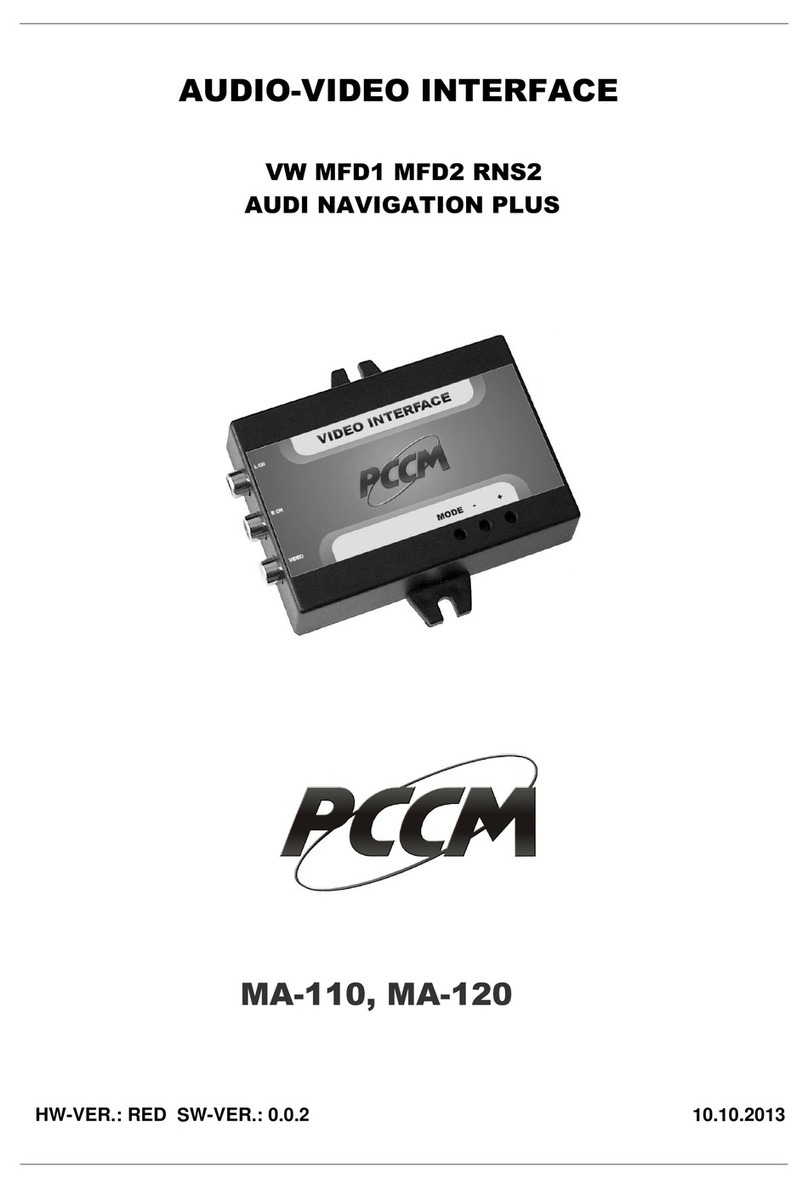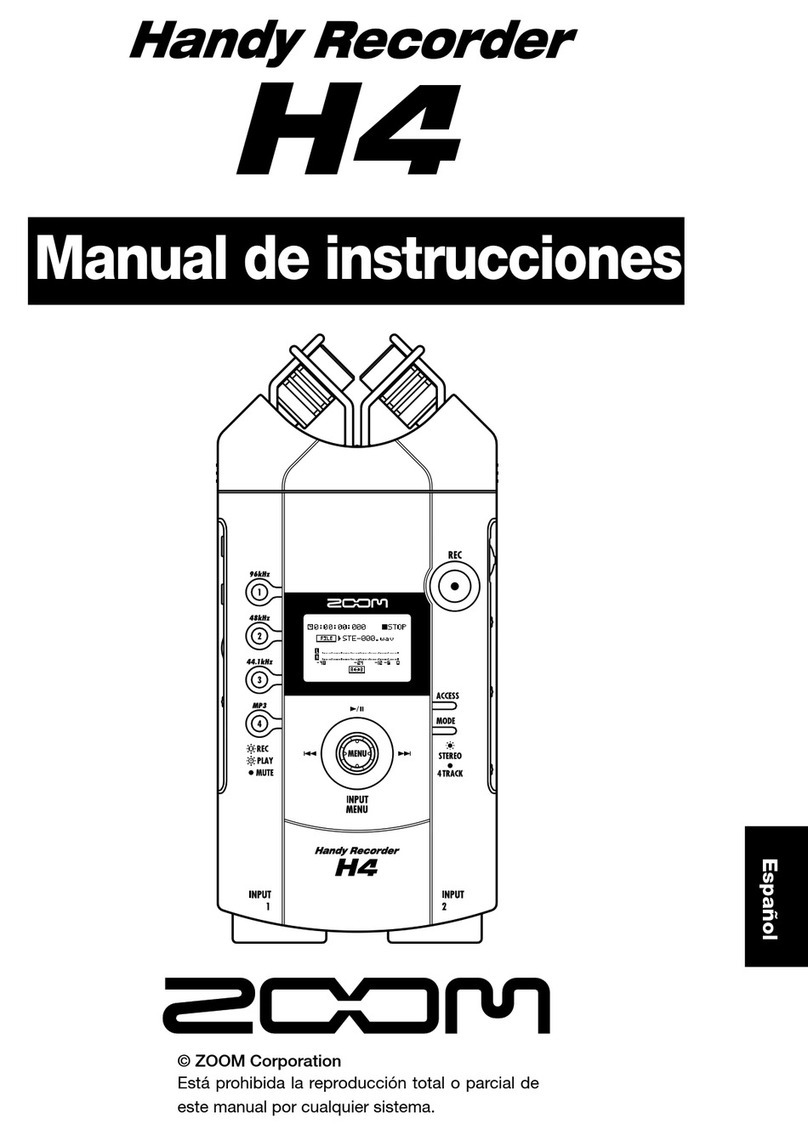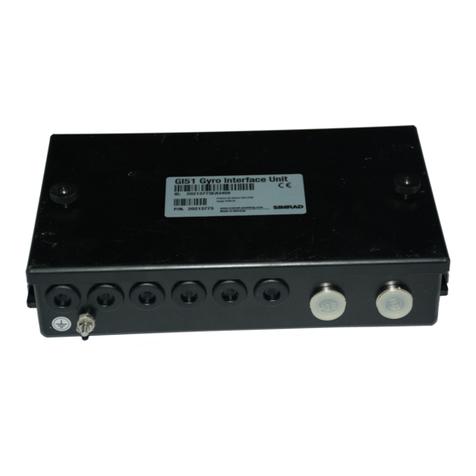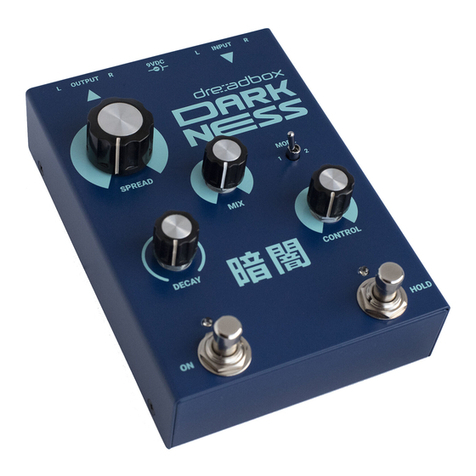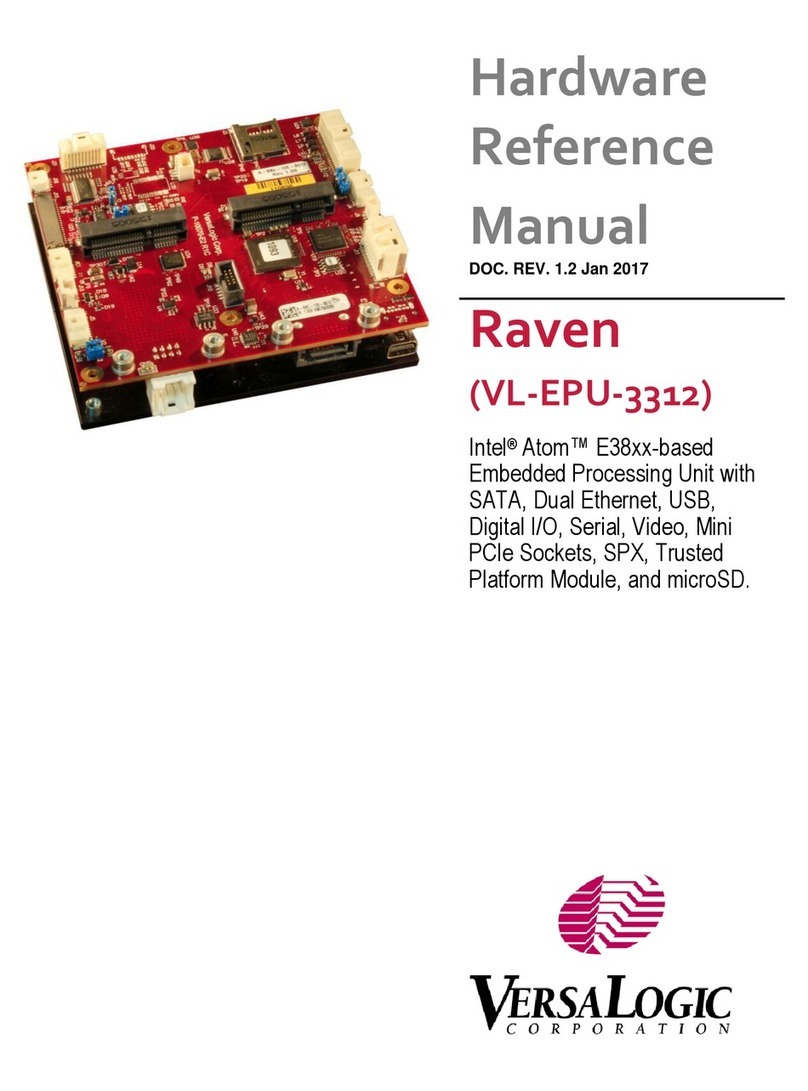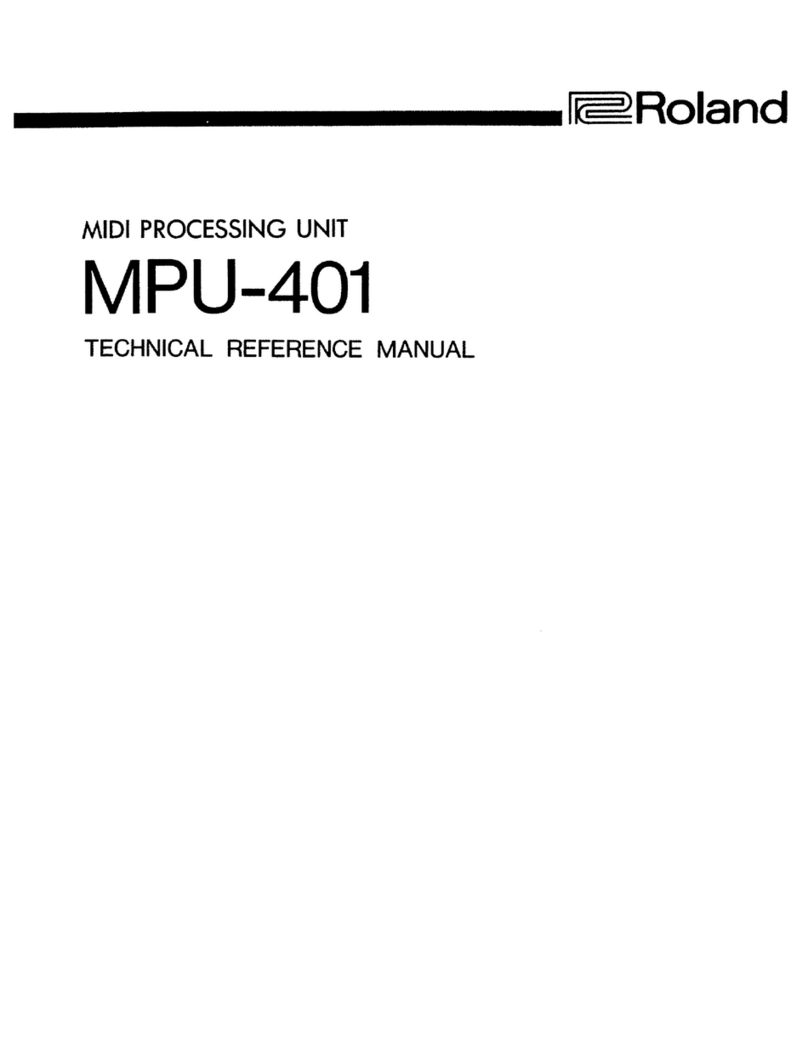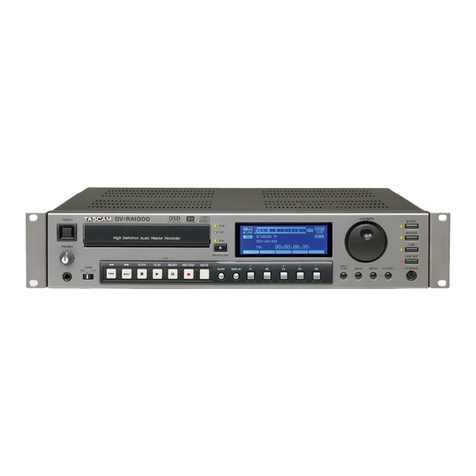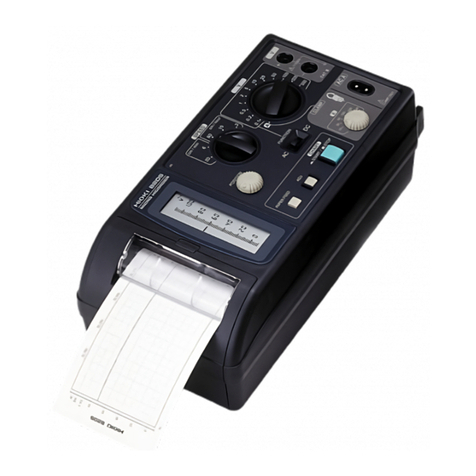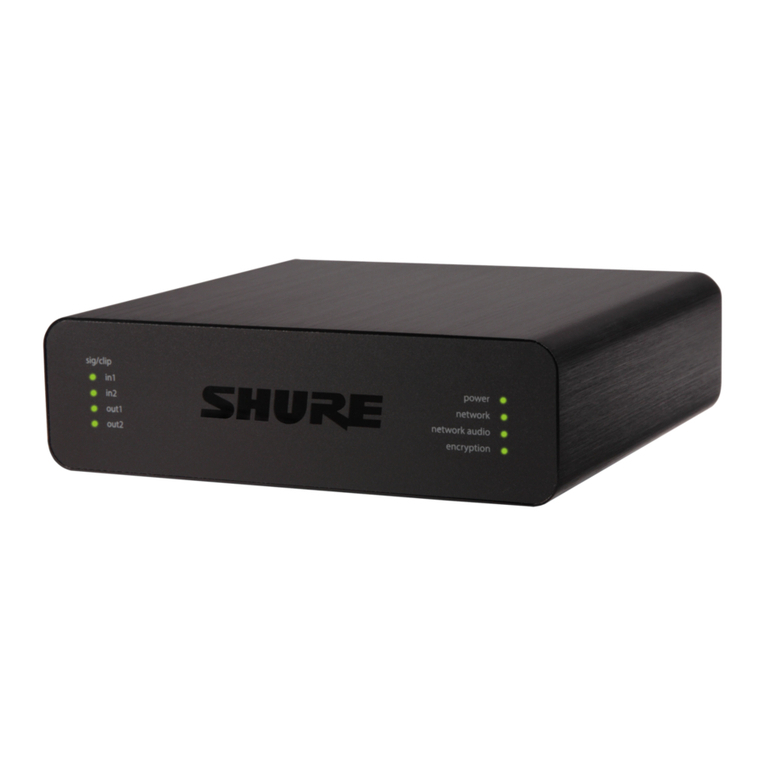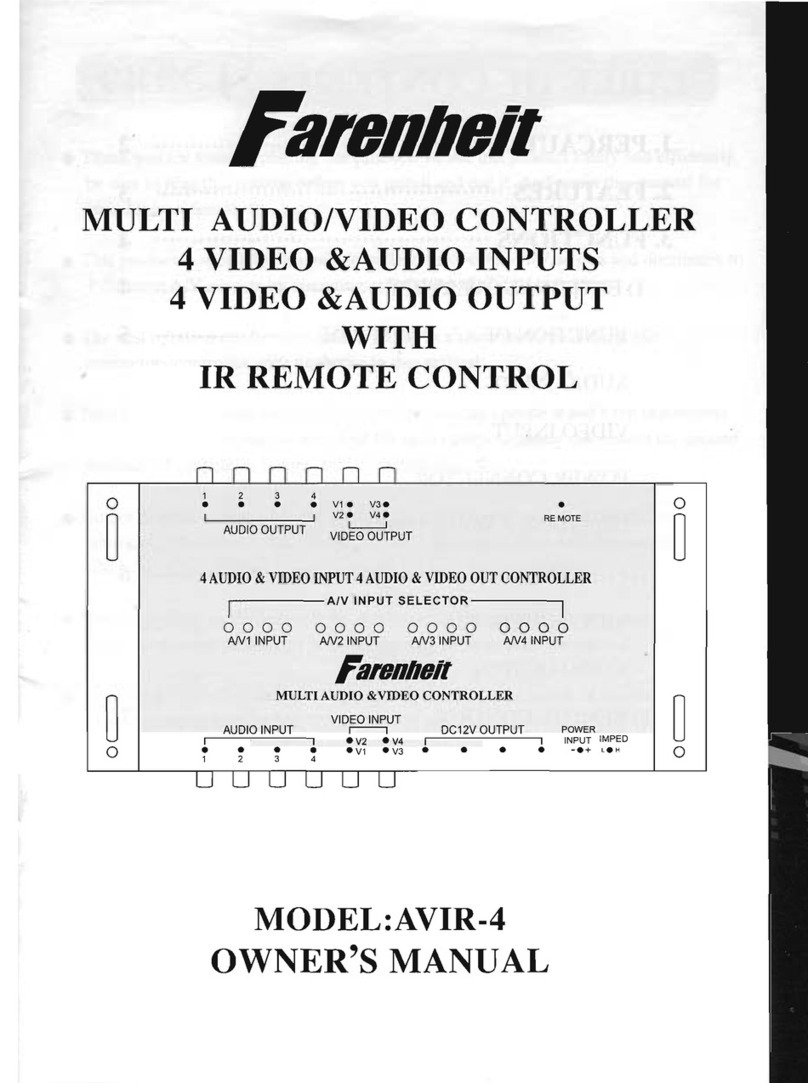Ude UDEVAC-500 Manual

Installation and
configuration manual
UDEVAC-500
36
1
rev.0
EQUIPOS Y SISTEMAS MEGAFONÍA / INTERCOM PUBLIC ADDRESS SYSTEMS
Tel.: +34 934 772 854 / +34 609 914 787
EN-54

36
2
Rev.1
UDEVAC-500
System description
Main functions
Control Panel SLA-500M / Expansion Module SLA-500S
Description
Main functions
Front panel
Rear panel
Technical characteristics
PZ-500F Fireman microphone
Description
Main functions
Front panel
Technical characteristics
PZ-500 / PZ-500E Microphone desk
Description
Main functions
Front and rear panel
Technical characteristics
Operation guide
Background music broadcast
Automatic emergency broadcast
Manual emergency emission
Warning with the emergency microphone
General announcement or by zones through the microphone desk
SLA-500SF Software
Description
Configuration and usage
Introduction to icons
Configuration software operation
Menu bar and tools
System Control Config Window
Control Window
State Window
System configuration Window
Log Window
Other Window
Index
3
3
4
4
4
5
8
11
12
12
12
13
14
16
16
16
20
20
20
20
21
21
21
22
24
25
26
27
28
28
35
36
17
19
20
20

36
3
610.592A
Rev.1
UDEVAC-500
The UDEVAC-500 Voice Evacuation System is an EN54-16 Certified Public Address and Voice
evacuation system. Generally used in facilities that need an evacuation system with only one
emergency call channel.
With its modular design, processing technology, and system performance diagnostics, its stability
and smooth operation are guaranteed. It is capable of playing background music in the absence of
an evacuation alarm. The user can preset the operation of an evacuation alarm, simple and intuitive
operation, it is widely used in: residential, hotels, railways, airports, factories and other places.
Integration of all functions in a single system.
500W Class D integrated amplifier.
Automatic issuance of evacuation and alert messages, and up to 255 voice messages to pre-
established zones.
Customizable alert and evacuation messages, stored on a SD card.
Supervision of loudspeaker lines A + B, spare amplifier and backup power supply.
Expandable capacity up to 120 zones using SLA-500S expansion modules.
Connection of up to 32 PZ-500 or PZ-500F remote microphones.
The system supports redundant wiring up to 600 meters between all system devices.
8 input remote controls (supervised) and 8 programmable output remote controls, 1 fault indicator
output, 1 EVAC mode indicator output, and 1 EVAC mode reset input
Description of the system
Main functions of the system
SLA-500S
EPD-500
SLA-500S
EPD-500
PZ-500P
SF-500
SLA-500M
EPD-500
PZ-500F
Line 1
Line 1
Line 1
Line 2
Line 2
Line 2
Line 3
Line 3
Line 3
Line 6
Line 6
PZ-500
Line 6
UDEVAC-500 System

36
4
610.592A
Rev.1
UDEVAC-500
The SLA-500M Evacuation Central is composed of a 500W digital amplifier, with the functions of transmitting
emergency messages, as well as evacuation messages by means of a PTT microphone.
The system has a capacity of up to 120 zones with functions of sending voice messages, BGM (Background
Music), and supervision of the amplifier and loudspeaker lines, with warning indicators in case of failure.
255 evacuation messages available.
6 speaker zones, with a maximum power of 500W, either in a single zone or distributed among all.
6 signal inputs for connecting analog microphones or external music sources. Maximum recording capacity
of up to 1000 events in the system log.
Connection of up to 32 PZ-500 or PZ-500F remote microphones.
The system supports redundant cabling (ring connection) between the SLA-500M control panel, the remote
microphones and the SLA-500S expansion modules, with a maximum length of 600 meters, using UTP
CAT6 cable.
Description
Main functions
SLA-500M Control Unit / SLA-500S expansion module

36
5
610.592A
Rev.1
UDEVAC-500
1. AC Power indicator.
Green AC power supply is currently operating normally.
Yellow AC power supply has a problem.
2. DC 24V indicator.
Green Backup power supply is working normally.
Yellow Failure of the backup power supply.
Off Computer does not have a backup power supply connected.
Note: In the rear configuration DIP switches (second switch on the SLA-500M and sixth switch on the
SLA-500S), if they are up they activate the supervision of the backup power supply, and downwards
they deactivate the supervision of the power supply backup.
3. Communication indicator between the control equipment and the expansion equipment.
Green Connection of the devices is normal.
Yellow That the physical connection fails or is not connected or configured.
Off No logical or physical connection between the control equipment and the expansions
4. Fault indicator.
Yellow System failure, press FAULT ACK to silence the alarm tone, although the LED will continue to flash.
Verify source of failure to restore system to normal mode.
Off System is working properly, unless the monitoring function is disabled.
5. Emergency microphone indicator.
Green Microphone is working
Yellow Microphone has been disconnected or is faulty
Off Microphone is OK, but not working.
6. Indicator test buttons.
Press this button to turn on all LED indicators to check that all indicator LEDs are working, including the SLA-
500M control unit, the SLA-500S expansion modules, and the PZ-500 and PZ-500F remote microphones.
7. Emergency button.
Red blinking System is in emergency mode.
Off System is in normal mode.
Front panel
1
2
3
4
5
6
18
19
7 9 10 12 13 14 15 16 17118
21 2322
20

36
6
610.592A
Rev.1
UDEVAC-500
Two ways to enter emergency mode and broadcast an emergency message:
1) Activate the emergency mode by pressing the red button with cap. Immediately the red light will start
flashing. Then select all or those areas where you want to launch the emergency message, and press the
"EVAC MSG" or "ALERT MSG" button as desired.
2) The automatic emergency emission can be activated by closing any of the remote controls Trigger Inputs
on the rear panel of the SLA-500M control unit and the SLA-expansion units.
Two ways to exit emergency mode and restore normal operating mode:
1)Press the red capped button on the front panel to end the emergency mode and to end the emergency
message broadcast.
2) The automatic way to exit the emergency mode is with a direct short circuit to the Emergency Reset Input
on the rear panel of the SLA-500M, then the evacuation voice message playback will stop and the zone
outputs speakers will be disconnected.
Note:
It does not matter if it is a manual input or an automatic input, the operating time and its activation can
be checked and reviewed in the LOG of the SF-500 software.
8. FAULT /ACK Button
If any system module during diagnosis fails, the FAULT indicator flashes, press the FAULT / ACK button to
stop the indicator flashing and the buzzer, until the equipment works normally the FAULT will stay on solid.
9. 9. EVAC evacuation message button and indicator.
Green Evacuation message is playing.
Yellow Evacuation voice message or SD card has been lost.
Off Everything is working in normal mode.
Note:
1. If any user wants to manually play the evacuation voice message, they must enter emergency mode,
select the zone or zones where they want to launch the message, and then press the voice message
key (EVAC MSG or ALERT MSG ).
2. In the system, by default, the priority of "evacuation" is higher than the "alert". Of course, it can be
modified with the SF-500 configuration software. If it is not a specific installation need, please do not
change the priority.
10. Line input selector for speaker zone outputs.
It is mainly used to select the external line input on this equipment. SLA-500M main unit audio inputs can be
routed to the SLA-500S expansion module outputs, but expansion modules audio inputs can only be used in
their own zones.
Note: Routing audio from one input to the desired outputs can be done and checked using the SF-500
control software. You can also enable or disable individualized routing for each host of one of its audio
inputs to its zones, from its own front panel.
11. All zones selector.
If the current zones are off, they will all turn ON; If all zones are armed, they will all be disarmed (OFF).

36
7
610.592A
Rev.1
UDEVAC-500
12. Speaker zone failure indicator.
Yellow Change in speaker impedance in circuit A or B, or the zone may be open or short-circuited.
Off Current impedance of the speaker zone loop is within the impedance measured when it was first installed.
Important note: it is necessary to carry out a measurement and subsequent recording of the
impedance to obtain the value of the impedance of the speaker circuit of each zone, if we connect new
speakers we must do the measurement again.
The method is as follows: on the rear configuration switches turn down the seventh switch, wait until
you hear alternate beeps from the buzzer and see the fault indicator light blink on the front panel, when
finished raise the seventh switch. When an impedance variation occurs in the speaker circuit that
exceeds ± 10-30% of the impedance value recorded by the equipment, the impedance variation will be
recorded in the LOG and the user will hear a beep and the fault light will flash will light up yellow. The
detection sensitivity of the zones is equal to or greater than 20W.
13. Message indicator with the emergency microphone or microphone desk (PZ-500).
When giving a voice announcement in one or more zones, this indicator will turn on to notify us that a voice
announcement is being made.
14. Indicator that a voice evacuation message is being broadcast in a zone.
When an evacuation or alert message is playing the indicator will light.
15. Indicator that the zone is playing background music.
In general, it is recommended to first select the zone or zones where you want to hear an audio signal, and then
select the audio input to be played in these zones. This selection and redirection of audio input signals to zone
groups can also be done from the SF-500 software.
16. Zone selection button.
To individually select the six output speaker zones. If none of the zone output indicators are lighting in
"PAGING", "EVAC / ALERT" or "BGM", one of them will be turned on by pressing this key (the corresponding
LED light is on according to the current output audio level) .
Note: If one of the zone indicator lights are on PAGING, EVAC / ALERT or BGM and is on, you can
close the zone output by pressing this key.
17. Attenuation of the output level of the output zone.
Increase or decrease the zone output volume individuallyup to 6 levels, with a maximum attenuation down to
-15dB.
18. Hand Microphone Input.
Input for emergency microphone or fireman's microphone with highest priority.
19. Monitor speaker attenuator.
Increase or decrease the volume of the monitor speaker.
20. Adjusting the output sensitivity of the handheld microphone.
Used to adjust the emergency microphone input sensitivity.
21. Treble control.
Increase or decrease the total treble output.
22. Bass control.
Increase or decrease the total bass output.
23. Master volume control.
Increase or decrease the overall volume level.

36
8
610.592A
Rev.1
UDEVAC-500
1. 24V DC emergency power input.
The DC24V power supply to be connected can be sealed lead acid batteries or similar products.
Note:
• Use an EN54-4 certified power supply.
• Please confirm that the DC24V power supply can provide the minimum operating current for the
correct operation of the SLA-500M. For example, working at maximum load (500W), the batteries must
be capable of supplying a minimum current of 27A, with which their minimum capacity must be 27Ah,
and their operating time at full load must not be less than 30 minutes.
2. Speaker zone outputs (A&B)
To connect line speakers
100 volts and 3-wire priority systems.
The output voltage is: 0 ~ 100 v.
Note: please do a speaker circuit
check after completing the wiring.
Zones that are not connected with
speakers should be set as
disconnected. This configuration
must be done using the SF.500
software.
3. DC24V outputs for 4-wire attenuators
For installations with a four-wire attenuators system. Limited output current for each output: 0.2 A.
Note: the output cannot exceed a total power of 28W.
4. Programmable control outputs.
These outputs will usually remain open, these outputs can be programmed with the SF-500 software to
activate or deactivate with automatic events or manual events.
5. Programmable control inputs.
These inputs will usually be kept open, these inputs can be programmed in the software SF-500 to enable or
disable them automatically or manually.
Rear panel
24V Override Output
ZONE 1
24V
-+
ZONE 2
24V
-+
ZONE 3
24V
-+
ZONE 4
24V
-+
ZONE 5
24V
-+
ZONE 6
24V
-+
Speaker Output 100V
ZONE 2
Line A Line B
0V C 100V 0V C 100V
ZONE 1
Line A Line B
0V C 100V 0V C 100V
ZONE 3
Line A Line B
0V C 100V 0V C 100V
ZONE 5
Line A Line B
0V C 100V 0V C 100V
ZONE 4
Line A Line B
0V C 100V 0V C 100V
ZONE 6
Line A Line B
0V C 100V 0V C 100V
Outputs of the loudspeaker zones (A&B)
24V outputs for 4-wire attenuators

36
9
610.592A
Rev.1
UDEVAC-500
6. LAN input for Configuration Software.
It is used to connect with the SF-500 configuration software, for programming and manual adjustment and
control operations.
Note:
1) Default IP address: 192.168.1.168, communication port number: 16888
2) To restore the default IP address, activate and deactivate DIP switch number 6 on the rear panel of
the control unit once.
3) If you want to change the ip address, please enable DIP switch number 5 to enable DHCP function.
Make sure the DHCP function is enabled.
4) The SF-500 software will help you to configure the SLA-500M evacuation equipment. All
communication cables must comply with TIE/EIA-568B standards, including connections to the SLA-
500S expansion modules and the PZ-500 and PZ-500F paging microphones.
7. Input for SLA-500 S expansion modules and PZ-500 and PZ-500F paging microphones.
Use a pin-to-pin CAT6 UTP cable (TIE / EIA-568B standard) to interconnect all the devices that make up the
UDEVAC-500 system, the maximum communication distance is up to 600 meters. Loop or star connection of
all connected equipment is possible, the SF-500 software will automatically detect the connection mode of the
system.
8. SD memory card for emergency messages.
System emergency messages are stored on the SD memory card, evacuation and alert messages are
monitored in real time, maximum capacity of 32 GB SD memory card. SD memory card supports a maximum
of 255 messages. Never handle this card with the equipment turned on. Do not delete or manipulate the files if
you are not sure, make a backup copy of the original files before making any changes, otherwise the
equipment may stop working and will not come under warranty. VERY IMPORTANT THE AUDIO FILES
MUST BE IN "WAV" FORMAT.
In the root directory of the SD card there are 3 folders:
- BGM folder for music.
- EVAC folder:
"alert_message" where the alert message is. To
change the alert message we must replace the
audio file by putting the new file (WAV) with the
same name as the one originally in the folder.
“evac_message" where the evacuation
message is stored To change the evacuation
message we must replace the audio file by putting
the new file (WAV) with the same name as the one
originally in the folder.
"log" where the event log is stored. where the equipment configuration is stored. VERY
IMPORTANT DO NOT HANDLE THIS FOLDER.
"parameter_disable_del" where the equipment configuration is stored. VERY IMPORTANT DO NOT
HANDLE THIS FOLDER.
- PROMPT folder: within this folder are the "Ding Dong" warning tones that are emitted at the beginning and at
the end of voice messages, the warning tones can be modified according to customer requirements and be
replaced by others (Format WAV) these tones are for all notification desks, these warning tones are not
supervised in real time, they are only supervised once when the equipment is turned on, so if there are no
warning tones or the file has been lost, do not will be warned as a failure.

36
10
610.592A
Rev.1
UDEVAC-500
9. Ground connection.
10. Backup amplifier input.
11. System fault output relay.
When the system has any fault, this relay output will close (normally open contact).
12. Relé de salida del modo de emergencia.
When the system operates in fire or evacuation mode, this relay will close (normally open contact).
13. Fire alarm reset input.
This input is used to connect with the Fire Panel, and allows the equipment to be restored to normal mode at
the end of the alarm, by means of a contact closure greater than 0.5 seconds.
• With the equipment in fire mode, this input allows the equipment to be restored to normal mode.
• When the equipment is in normal mode, no process occurs if this input is activated.
14. Input with sensitivity adjustment for MIC (microphone) or line (line) and XLR connector.
15. Input with sensitivity adjustment for MIC (microphone) or line (line) and XLR connector.
16. Potentiometer for adjusting the sensitivity of each of the inputs.
17. Inputs with sensitivity adjustment for line (line) and RCA connector.
18. REC recording output.
This Rec output is the mixed output of all audio
inputs so that you can record with other
equipment.
19. DIP switches for configuration of control
or expansion equipment functions. DIP DIP
switches for configuration of functions of the
control or expansion equipment. Up means
"enable" and down means "disable".
SLA-500M main equipment:
Switch 1, above activates the general supervision of the system (amplifier, speaker lines, etc.). Down
disables supervision.
Switch 2, above activates emergency power supervision. Down disables emergency power supervision.
Switch 3, above enables the trigger inputs as contact activation. Below enables the trigger inputs as voltage
level activation.
Switch 4, above indicates there is a spare amplifier. Down indicates there is no spare amplifier.
Switch 5, above enables DHCP. Below disables DHCP.
Switch 6, resetting the IP address, normally upwards, moving downwards and immediately upwards resets
the IP adress of the device to its factory value.
Switch 7, make an analysis of the impedance of the loudspeaker lines, normally upwards, move
downwards and immediately upwards allows to perform the acquisition of impedance values of the
loudspeaker lines.
Switch 8, above activates the supervision of the loudspeaker lines. Down disables loudspeaker line
supervision.
SLA-500S expansion module:
DIP switches 1 to 5 are used to configure the
identification number of the extension equipment.
The 6th switch is to configure the 24VDC input. The
7th switch is to configure the backup amplifier. The
8th switch is to configure the loudspeaker line
supervision function.

36
11
610.592A
Rev.1
UDEVAC-500
Technical characteristics
Model SLA-500M SLA-500S
Description Control equipment
Control equipment
Expansion unit
AC electrical part Power supply AC220V-250V, 50/60Hz
Power consumption 650W
Maximum current <3A
Fuse 250V/5A, low speed type
DC electrical part Power supply 24V DC, 20V-27.5V
Maximum current <27A
Microphone
Emergency
Sensitivity 5mV
Impedance 600Ω
Line inputs 1-6 THD <1%, at rated output power, 1kHz
Sensitivity 775mV
Impedance 10kΩ
S / N Ratio >70dB
Control input &
departure
Fault output Closed circuit, no voltage
EVAC Output status Closed circuit, no voltage
EVAC input Reset Closed circuit, no voltage, T> 0.5s
8 control outputs Closed circuit, no voltage
8 control inputs Way-1: closed circuit, no voltage
Emergency
message
Format WAV
Memory card SD memory card
Capacity 32G
No. of messages 255 Max
Period 10 years
SD Card Format FAT/FAT32
Log (events)
Format HEX
Way to store Nand Flash
No. of events 1000
Period 10 years
Work environment Operating temperature +5℃ ~ +40℃
Storage temp -20℃ ~ +70℃
RH < 95%
Mechanical
specs
Dimensions 484(W)x132(H)x449(D)mm (3U)
Net weight 11.5kg
Rack mountable 19" rack mount
Finish Aluminum plate and metal case in black

36
12
610.592A
Rev.1
UDEVAC-500
PZ-500F fireman microphone
The PZ-500F is an E54-16 compliant, wall-mounted, fireman warning microphone.
Fireman's microphone according to EN 54-16.
"EVAC MSG" or "ALERT MSG" activation buttons for all zones simultaneously, "FAULT ACK" button,
plus 4 programmable emergency buttons.
Remote emission of pre-recorded messages in case of emergency.
Top priority supervised PTT microphone.
Microphone signal monitored in real time.
Configurable as PTT or normal.
24V DC phantom power from SLA-500M or SLA-500S.
Status LEDs for AC, DC, Fault, Mic and Test.
Communication distance up to 600 meters.
Up to 32 fireman microphones supported in the system.
Redundant connection in loop mode with the rest of the system's devices, using UTP CAT6 cable.
Internal DIP switch for setting the device ID (addressing).
Front door with key lock.
Description
Main functions

36
13
610.592A
Rev.1
UDEVAC-500
Front panel
1. Equipment power indicator.
Green system has an AC or DC power failure.
Yellow system works well AC and DC supplies are normal.
2. Equipment and system status indicators (FAULT)
Yellow failure of some module or system equipment, please press "FAULT ACK" to cancel the warning
buzzer. (blinking) new failure in the equipment, to inform the user.
Off all modules in the system are operating normally.
3. Handheld microphone status indicator
Green microphone is working, giving a warning.
Yellow the microphone is faulty.
Off microphone is normal.
4. Handheld microphone status indicator
In any state, press this button and all LEDs will light. Used to confirm that the LEDs are working properly.
5. Emergency button and indicator.
Red (blinking) equipment is in emergency mode.
Off equipment is normal mode.
To make an emergency warning broadcast:
A) ) Activate emergency mode by pressing the red button with cover and immediately the red light will start
flashing. and then press the EVAC MSG or ALERT MSG buttons, which will activate the warning in all zones of
the system.
B) The automatic transmission of an emergency will be activated by closing any of the rear inputs remote
controls of the control unit or the expansion unit and the red light will flash.
Emergency mode reset:
A) Press the ACK / RESET button on the front panel to end the emergency mode and to end the emergency
message broadcast.
B) The automatic way to exit the emergency mode is with a direct short-circuit in the Emergency Reset Input
on the rear panel of the SLA-500M, and then the playback of the evacuation voice message will stop and the
exit zones will speakers will be disconnected. These events are logged and can be viewed in the SF-500
software's history (LOG).
10
12
11
9
1
2
3
46
7
5
8

6. FAULT ACK button
A) All the modules of the system are supervised and the diagnosis is normal, if we press this button when the
FAULT light is not flashing, the equipment will not do any action or process.
B) ) If any module in the system has any fault, the FAULT indicator light will flash, press the FAULT ACK button
and the FAULT indicator will stop flashing and the buzzer will stop until another fault is detected then the
FAULT indicator starts to flash again and the buzzer to sound.
7. EVAC & ALERT Message buttons and indicators.
Green voice message or alert is playing EVAC MSG / ALERT MSG
Yellow a voice message, alert or the SD card has failed.
Off voice message or alert is not being played.
If you need to manually play the evacuation voice messages, you need to enter the emergency mode and then
press the EVAC MSG or ALERT MSG button.
By default in the system the evacuation message has priority over the alert message. You can change the
priority through the SF-500 software. If due to special installation requirements it is not essential, please do not
change it.
8. Programmable function buttons and indicators.
Blink indicator programmed function is active
Off programmable functions are disabled
9. Lock
10. Hand microphone
It is mainly used to guide people in an emergency situation:
11. Wiring entry
12. DIP switch for setting the device ID (addressing). Configuration of the "ID" of the equipment by
means of the DIPs.
Raised in position ON means that it is activated and lowered means disabled. From the 1st to the 5th switch
are to configure the address / identification of the microphone through a binary system. The 6th switch up
means that the voice prompts mode is normal and down means the voice prompts mode in PTT mode. The 7th
switch up means that this microphone gives announcements in individual zones and down means that the
group of zones for the announcement of this microphone, as a group could be defined with several zones.
The 8th switch is to activate all the LEDs as a test of these indicative LEDs, downwards it activates the test of
the LED indicators, all the LED indicators will light up in red-green-yellow to know their normal operation.
Below is an example configuration of the announcement microphone from number 1 to 4.
2 4 168
PTT
Z/G1
VALORES ASIGNADOS A CADA DIP
Test
2 3
ON
54 6 7 81
2 4 168
PTT
Z/G1
VALORES ASIGNADOS A CADA DIP
Test
2 3
ON
54 6 7 81
2 4 168
PTT
Z/G1
VALORES ASIGNADOS A CADA DIP
Test
2 3
ON
54 6 7 81
2 4 168
PTT
Z/G1
VALORES ASIGNADOS A CADA DIP
Test
2 3
ON
54 6 7 81
36
14
610.592A
Rev.1
UDEVAC-500
Values assigned to each DIP switch

36
15
610.592A
Rev.1
UDEVAC-500
Technical characteristics
Phantom power
Voltage 20V ~ 27.5V
Maximum current
Consumption Less than 3W
MIC Performance
SPL 30mV
Mechanical specifications 298 x 298 x 89 mm
Net weight 3.8KGS
Installation Desktop
Colour Black
Environmental requirements
Operating temperature +5ºC ~ +40ºC
Storage temperature -20ºC ~ +70ºC
Relative humidity <95% without condensation
Less than 0.2A (with 24V power, all LEDs
on and in voice prompt mode)

36
16
610.592A
Rev.1
UDEVAC-500
The PZ-500 Microphone Desk and PZ-500E Expansion Keypad allow users to select paging zones
remotely. It has a 12-zone capacity that can be expanded with the expansion keyboard and allows
you to connect up to 32 looping microphones.
Remote microphone of the Digital Voice Evacuation.
System. Microphone with 12 zone capacity.
It can be expanded to 12 more zones through PZ-500E.
The system supports 32 remote looping microphones.
12 zone selection buttons with three-color indicators.
Two RJ45 ports for link input and output.
Communication cable or CAT6 up to 600 meters.
Description
Main characteristics
Microphone desk PZ-500 and expansion keyboard
PZ-500E

Panel frontal y posterior
1. Device status indicator "busy"
Green equipment is busy, please wait.
Off free and can be used to call a specified zone.
2. Microphone
The gooseneck microphone has a luminous ring, lit red indicates that it is ready to give a voice warning.
3. Speaker Zone Status Indicators
Steady light current speaker zone is activated and in voice announcement.
Flashing light user is selecting this speaker zone.
Off speaker zone is not currently working and is on standby.
4. Zone selection buttons
5. All zones selection button "ALL"
Used to select all zone groups.
6. Voice announcement Start Button
To start voice prompts with the microphone.
Description of operation:
1. When a voice announcement is being made, if we press this button, the voice announcement will end;
2. When there is no voice prompt and a zone is selected, press this button to start the voice prompt
(you need to wait for the microphone light to turn on).
Note: If the microphone is in PTT mode, it will be necessary to keep pressing the button, otherwise the
voice announcement will end (PTT this mode is explained in point "11" of this manual, later).
7. Switch
36
17
610.592A
Rev.1
UDEVAC-500
2
1
3
3
3
3
4
37 8 9 10 11

36
18
610.592A
Rev.1
UDEVAC-500
8. Connection inputs with other system devices
9. Microphone output sensitivity regulation
10. Line input for external audio
11. Device ID configuration DIP switch
From the 1st to the 5th switch are to configure the address / identification of the microphone through
binary system.
"6" Operation in normal mode;
Unplugged - indicates that it works in PTT mode, it must be held down to make the voice
announcement;
"7" Allows you to test the microphone indicator LEDs, normally up, lower and raise it immediately to
perform the test.
"8" End of line resistor.
Above indicates disabled, below indicates enabled.
1(000000) 2(100000) 3(010000) 4(110000) 32(111110)
Nota:
1. If the PZ-500F, PZ-500, PZ-500P or SLA-500S cannot communicate normally with the main
equipment (SLA-500M), activate the end-of-line resistor of the last connected equipment at the end of
the line. The PZ-500F firefighters microphone cannot be the last equipment in the installation, this
resistor is only for star wiring not for loop-type wiring.
2. If the installation is like Figure 2, the resistor should not activate.
FIG 1 FIG 2
Conexión en lazo Conexión en loop

36
19
610.592A
Rev.1
UDEVAC-500
Technical characteristics
Model PZ-500
Description Microphone notification desk
System capacity 32 units
Communication distance
600 meters
Connection system
Star or redundant loop connection
Number of zones 12 zones o 12 groups
Announcements mode PTT or normal mode
Electrical parts Supply Voltage 20V-27.5V
Maximum Current <0.1A
Consumption <2.4W
Line input Sensitiviy 775mV
Impedance 10k Ω
S/N Ratio >70dB
Microphone input Sensitiviy 5mV
Impedance 600Ω
Working environment Working temperature +5℃ ~ +40 ℃
Storage temperature -20℃ ~ +70 ℃
Relative humidity < 95%
Mechanical part Dimensions 240(W) x 140(D) x 55(H) mm
Weight 1kg
Finish Aluminum case in black

36
20
610.592A
Rev.1
UDEVAC-500
Operation guide
Background music broadcast
Connect the audio sources or microphones to the inputs on the rear panel, select the line input via
the input source selector on the front panel of the main equipment or expansion equipment, connect the
zone output with the corresponding background music indicator means that music is playing in that area.
Note: Emergency messages and microphones are common between main equipment and
expansion equipment, while line inputs 1-6 are only for the equipment itself.
Automatic emergency broadcast
From the normal state, connect a fire panel or other external control equipment to the 8 control input
terminals (Trigger inputs) of the main equipment or an expansion one. The control input terminals receive a
contact from a fire panel or other external control equipment and then a general emergency message will be
issued. At the same time, a control output will be activated on the control equipment to activate third-party
equipment. There are two kinds of control inputs, by contact (short circuit) or by voltage level. Press the
emergency button or remote reset input again to end the emergency broadcast.
Manual activation of the emergency message
Press the emergency button, it will light up red, then select the zone and press the EVAC MSG or Alert MSG
button. For the manual emergency broadcast to work the message indicator light and the zone evacuation
light must be on. Press the emergency button or remote reset input again to end the emergency broadcast.
Warning with the emergency microphone
Press the side button of the emergency microphone to make the
emergency announcement to all zones at any time (in the process the
user can manually activate or deactivate the loudspeaker zones, by
default all partitions and zones are activated), the tone The pre-
announcement will sound first and the EMG microphone indicator will
light indicating that it is ready for the emergency announcement,
release the microphone to end the voice announcement. This
emergency microphone circuit is always supervised in real time.
General announcement or by zones of a microphone notification desk
Select the zone or ALL (in the selected zone or zones the green LED will flash), press the call button to make
the voice announcement with Chime (the green zone LED will light up steadily). Under PTT mode, the call
button must be held down to make any voice announcements.
INPUT1-6
Table of contents
Other Ude Recording Equipment manuals
